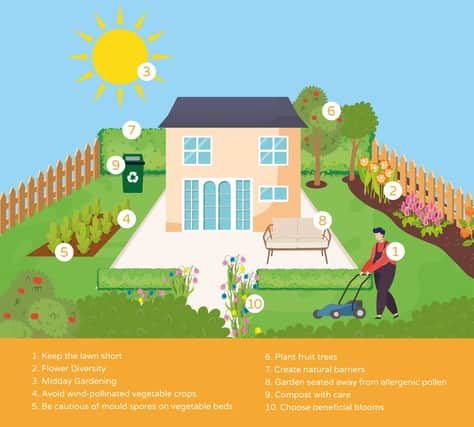Top ways to enjoy gardening and keep your hayfever at bay


In an effort to make the best of a warm spring, almost half of the UK have taken to gardening during the coronavirus lockdown.
While this is a great hobby for many, for the 13 million hay fever sufferers in the UK the spring and summer months can prove a challenge.
Advertisement
Hide AdAdvertisement
Hide AdWith the importance of fresh air to mental health and wellbeing clear, money.co.uk has worked with gardening expert Jackie Herald to put together some tips and tricks to help hay fever sufferers enjoy a beautiful garden this summer.
She also recommends the flowers you should grow.
Top tips for low-allergen gardeningKeep the lawn short during the summer months. This helps to prevent the growth of lawn flowers and means less grass pollen is released into the air.Flower diversity is important. Choose a range of blooms with different flowering months, for both biodiversity and long-lasting visual impact. If you’re planning a cutting garden, avoid flowers with a strong scent, as these can be overpowering when you take them indoors.
Midday gardening is your best option. Pollen levels are at their highest at the beginning of the day, as they rise with the warming air, and again at the end of the day when it’s cooling down. So avoid gardening at these times if you suffer from hay fever. Try and stick to noon to 4pm.
Avoid wind-pollinated vegetable crops. Plant delivery company Rocket Gardens has highlighted that the increased time we are spending gardening has resulted in an over 600 per cent rise in sales of its organic vegetable, herb and fruit plantsIf you suffer with hay fever, avoid wind-pollinated crops such as sweetcorn and peas. Instead look to plant leafy greens and root vegetables, such as lettuce and beetroot.
Advertisement
Hide AdAdvertisement
Hide AdPlant fruit trees or another low-allergy species. These offer spring blossom, summer fruit and good autumn colour. Apple (Malus), cherry/plum (Prunus), rowan (Sorbus) and juneberry (Amelanchier) are best to plant. Aim to avoid wind-pollinated trees that may cause hay fever flare ups, such as alder (Alnus), hazel (Corylus) and birch (Betula).
Create natural barriers like hedges to capture and filter pollutants. However, be wary of certain species of hedge, such as yew (Taxus), laurel (Laurus), beech (Fagus) and hornbeam (Carpinus) as they can trigger hay fever.
Compost with care as compost bins can act as a source of mould spores, which are even finer than pollen and hold the risk of reaching deep into the respiratory system. Keep the bins well away from seating areas and ensure you cover them up, as well as using gloves when handling them.
Watch out for mould spores on vegetable beds. Due to vegetables benefiting from well-drained soil, many choose to grow them in a raised bed. If it’s made of timber, make sure to line your bed with a waterproof membrane to prevent the timbers from rotting and producing mould spores.
Advertisement
Hide AdAdvertisement
Hide AdThink about your garden seating as positioning is important. Gardening takes patience and effort, so make sure you take the time to relax and enjoy the fruits of your labour.
Just ensure you keep your garden seating well away from the more allergenic pollen sources and any potential mould spores.
Choose beneficial blooms as generally what’s good for bees and other insects is good for us too. Prioritise insect-pollinated plants, many of which are bell, funnel or trumpet-shaped so that insects have to probe inside to reach the pollen.